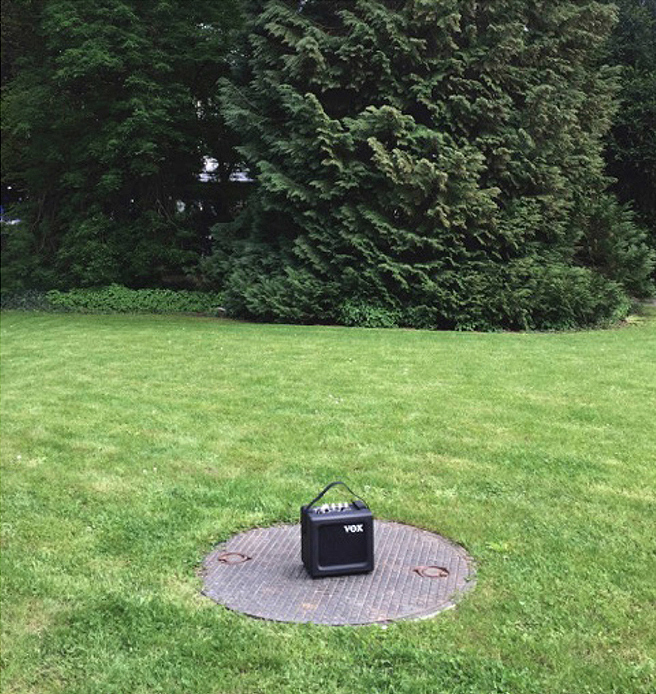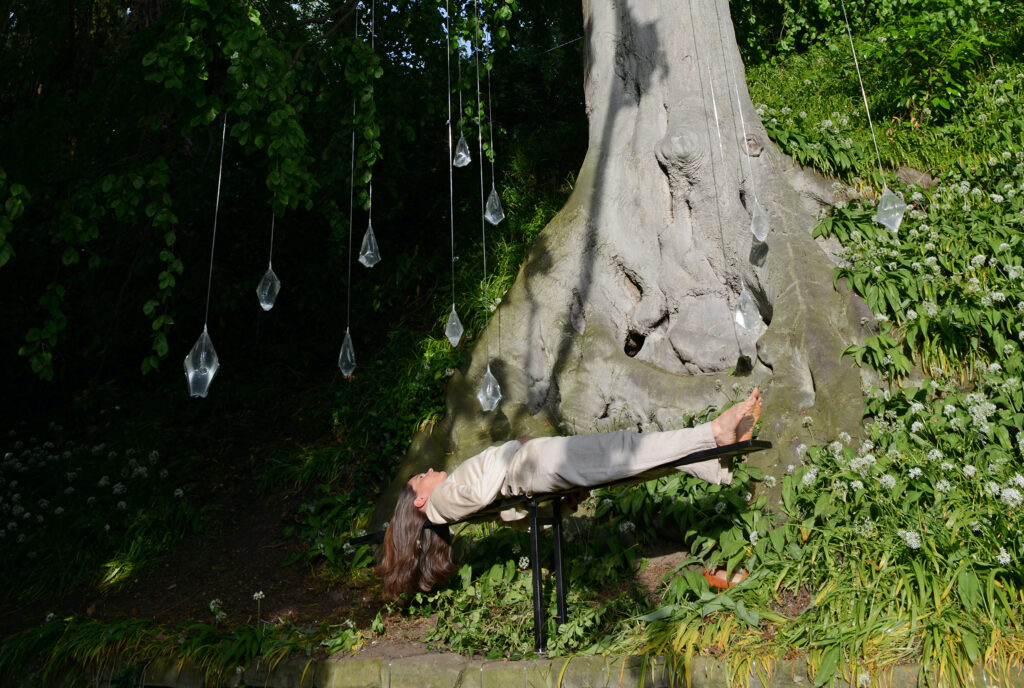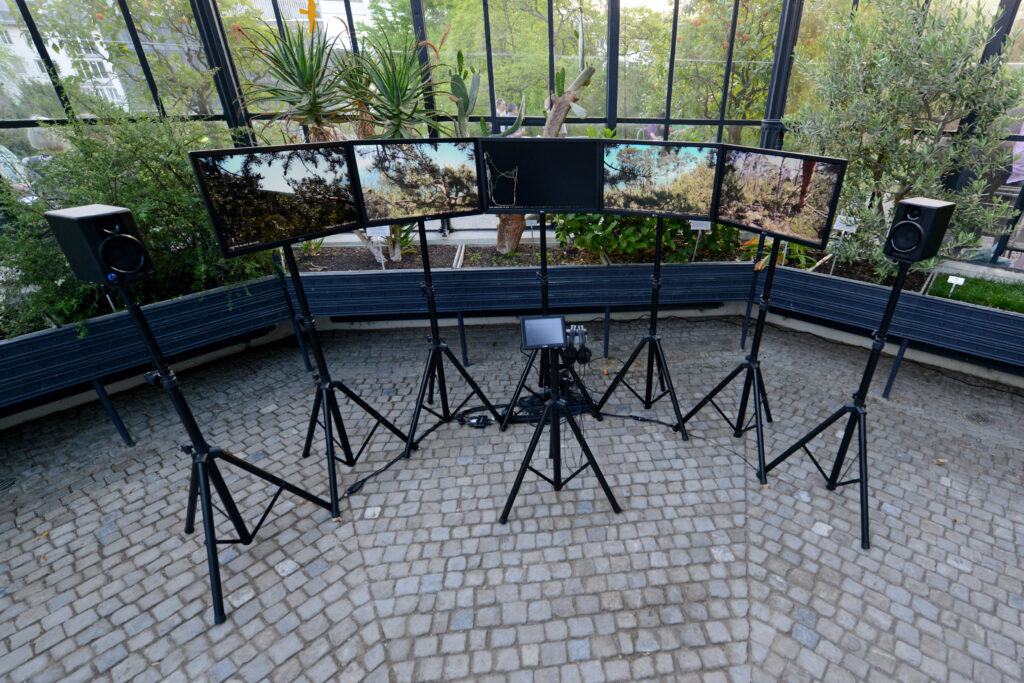In the old Botanical Garden, various art performances und installations were integrated in the Climate Garden.

TREETMENT – a perfomative conversation by Zoe Tempest and Laura Zachmann
In a tour of the Old Botanical Garden, you will meet with us different trees that are affected by climate change, both for better or for worse. Our faithful companion VOX transports the voice of Regula Imboden, who speaks in a humorous and poetic way of the individual concern of the trees. With special gestures in pictorial body movements, we prepare you for the stories of seven trees.

Labile’s balance
Isabel Rohner creates a kind of altarpiece in her performance, which refers to the delicate balance in which we all find ourselves. For a longer period of time, she lies in a meditative state in front of the mighty trunk of a mourning beech on a seesaw and tries to keep herself in limbo. An installation of water bags and transparent water hoses connects them to the trees and the ground, creates a stage design for the performance, generates further levels of meaning. Climate change brings with it changes to which all living beings must react. If these changes can be absorbed and a new balance can be found, the unexpected and the new can emerge.
AHNUNG DES ABSCHIEDS – a graphic staging of Regina Simon
I am devoted to all the trees and feel connected to them, for there is a goodwill from them that is good for me.
I am saddened by the idea that the grey pillars of our forest halls, the red beech trees, can disappear due to climate change. In this sense, it is an honour for me to draw the annual rings of the beech in the Old Botanical Garden in Zurich, estimated to be 120 years old. Starting from the middle, I draw the 120 annual rings of the beech on paper with a pencil .
Since the tree is still healthy and growing, I have no insight into its real annual rings and therefore imaginarily interpret the good water-rich years with broad annual rings and the lean dry years with narrower ones. To make a connection to the tree, I will begin with a lyrical ceremony; this also to highlight different approaches to science and art.
Radio play on the cypress tree – Francoise Caraco, Simon Grab
As a radio plays on the cypress tree, Francoise Caraco and Simon Grab stage a text collage with sound, light and video, which they play acoustically and visually in the garden.
The cypress has become the subject of myths and classification systems, now it appears on the spot as a “concrete plant”. Against the backdrop of the botanical garden, listeners are invited via a radio play, to the imaginative journey, in time rooms around the Mediterranean, until the image of the cypress in a Swiss landscape becomes concrete: will we be under cypress trees in the future, breathe sweet fragrance without thinking of the sound of the sea?

trees: Pinus sylvestris Ein künstlerisch-wissenschaftliches Beobachtungssystem
Sounds of plants and data sonification
Plants produce noises. Most of these acoustic emissions are caused by dry stress: thirsty trees make inaudible noise in the ultrasonic area – sounds from plants allow conclusions to be drawn about their condition and environmental conditions. The media art installation “trees: Pinus sylvestris” depicts the life of a forest pine (Pinus sylvestris) during the main growth phase in May/June 2015. With special sensors, the acoustic emissions of a forest tube above Salgesch were recorded and ecophysiological measurement data (e.g. b. the changing trunk and branch radii depending on the water content, the juice flow rate in the branches, the water present in the soil, humidity, solar radiation, etc.) sonified, d. H. translated into sounds. The images and the sonified measurements were used in an artistic-scientific observation system that tosses the temporal and spatial connections between plant noise, physiological processes and environmental conditions. Represents.
Forest pines in Valais
As one of the driest valleys in Europe, valais is particularly clear about the effects of climate change in the Alpine region. The observation system shows how the forest tubes in the Valais react to ever longer periods of heat and drought. The many dry stress noises already occurring in the spring during the growth phase (audible as loud crackers) indicate the predicament of the tree shortly after the start of the vegetation phase. In order to grow, trees must have the water potential in the dividing tissues (e.g. the Kambium) well above the level, whereby embolisms (so-called cavitations) occur in the vessels. Cavitation noises at this early stage of the year clearly indicate that growth is already inhibited by the prevailing water conditions. If the rain is absent during this period, the tree subsequently restricts transpiration and thus carbon assimilation and also grows significantly worse. As a long-term result of increasing drought due to climate change with ever longer periods of drought and heat, the trees become susceptible to diseases and parasite infestations.
The research project
trees: Making ecophysiological processes audible” was a joint research project of the ZHdK and the WSL. Noises produced in plants have been linked to ecophysiological processes. Normally imperceptible phenomena and sequences were made artistically experienceable.
Artistic Research and Realisation: Marcus Maeder, Zurich University of the Arts ZHdK
Ecophysiological Research: Roman Zweifel, Eidg. Research Institute for Forest, Snow and Landscape WSL. Funding: Swiss National Fund.

